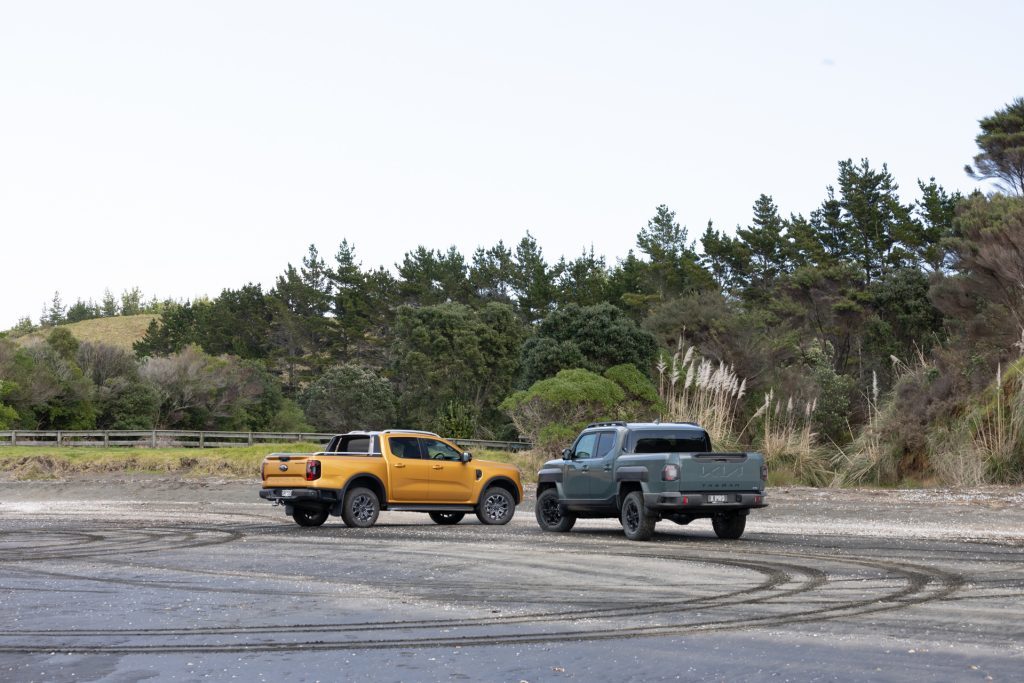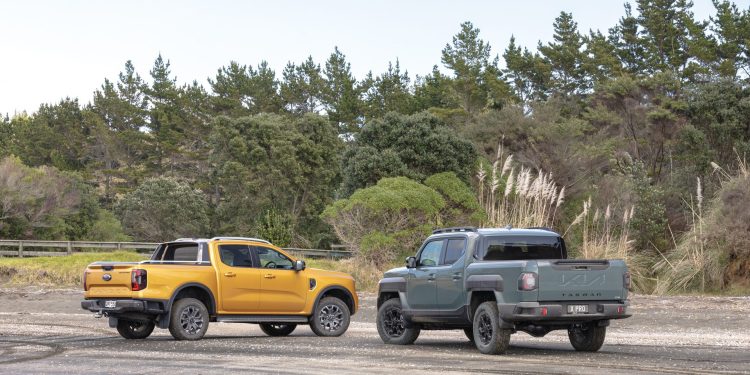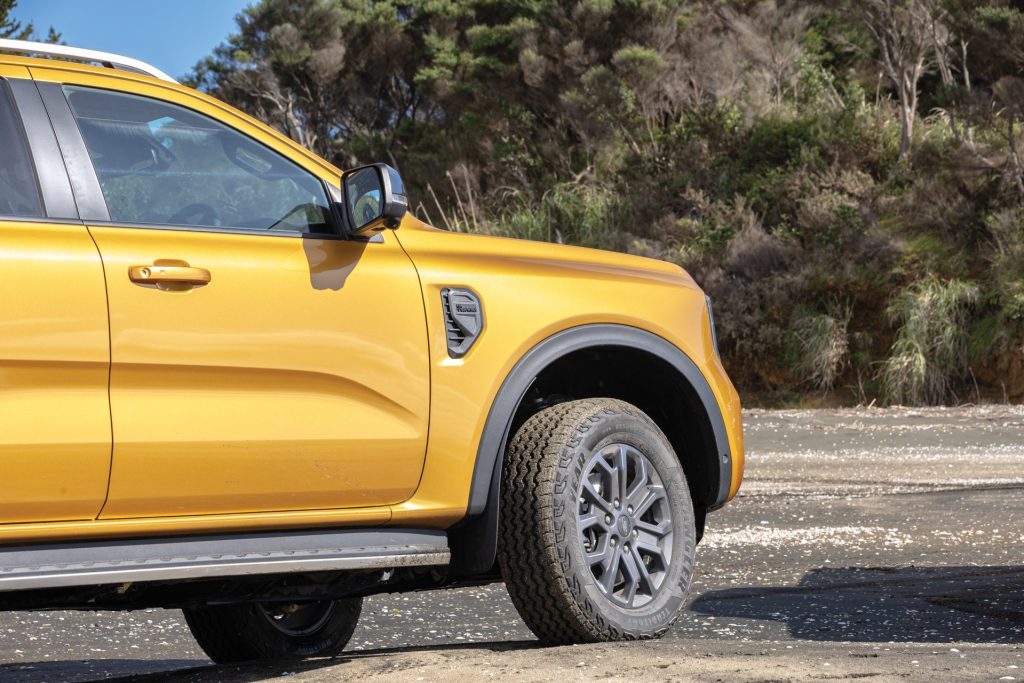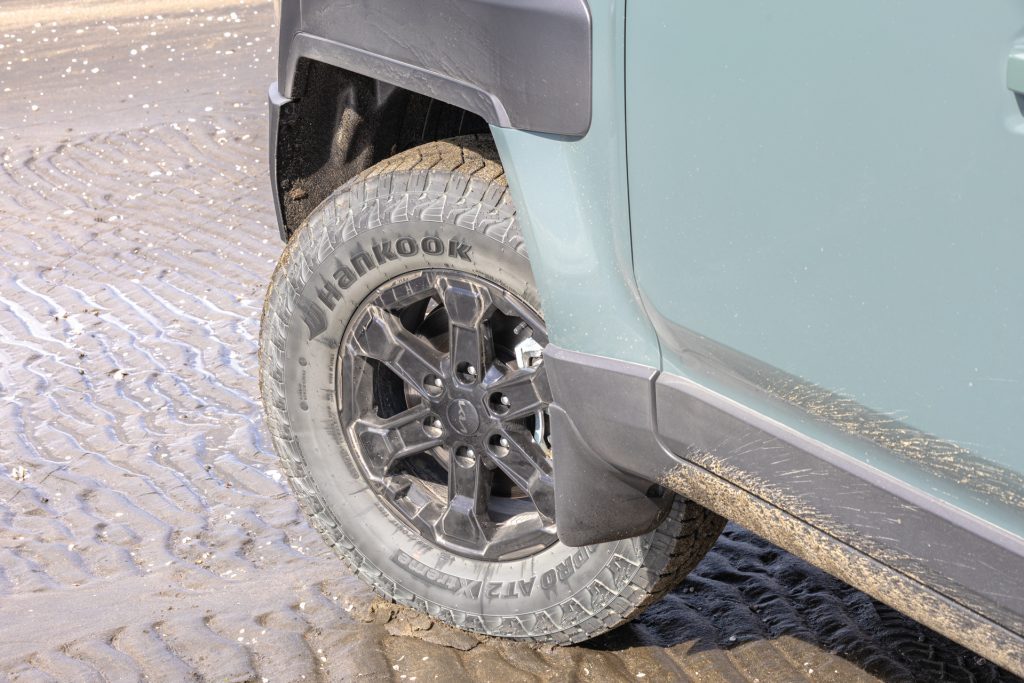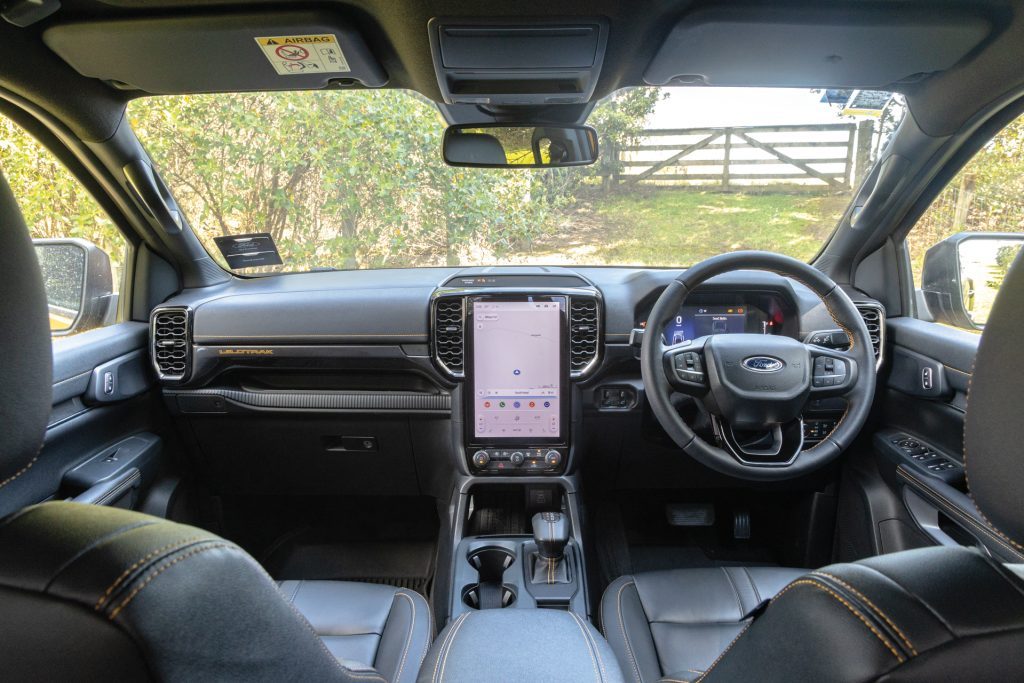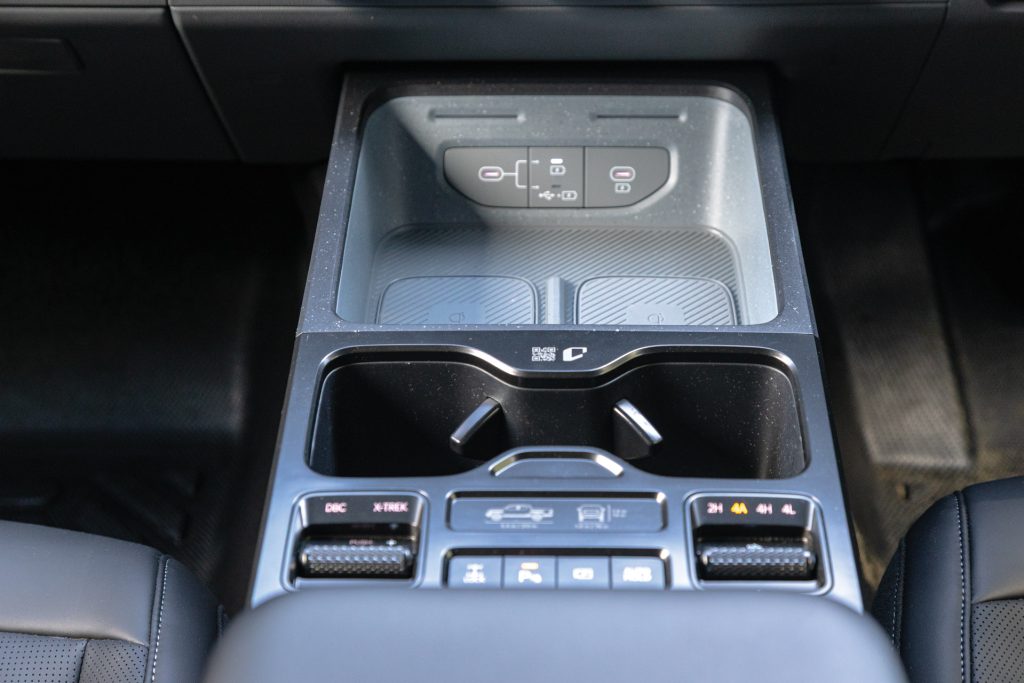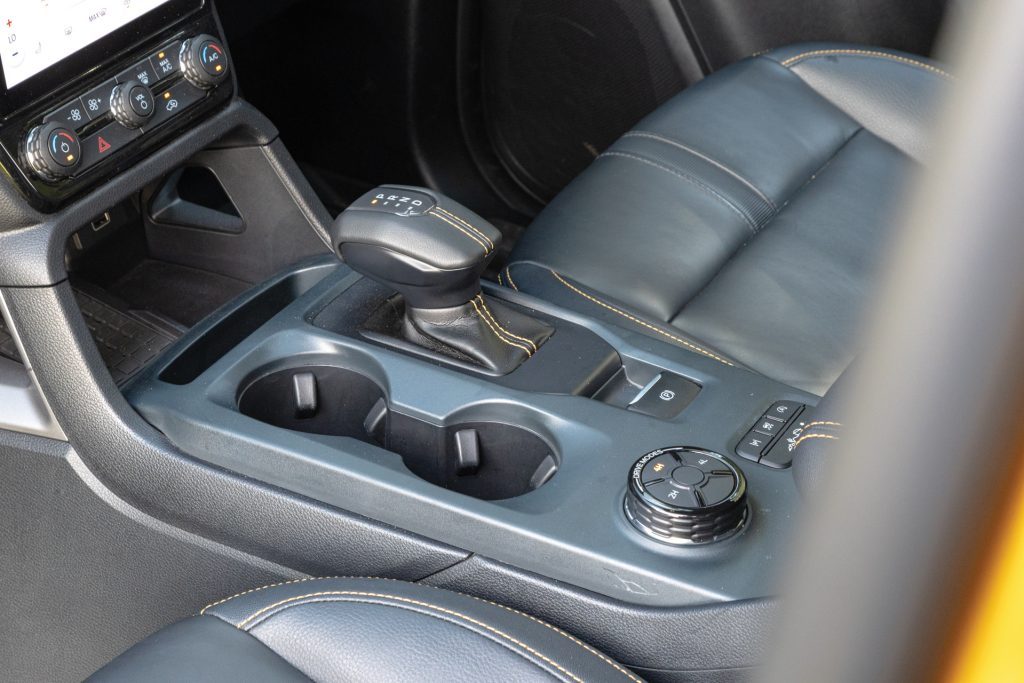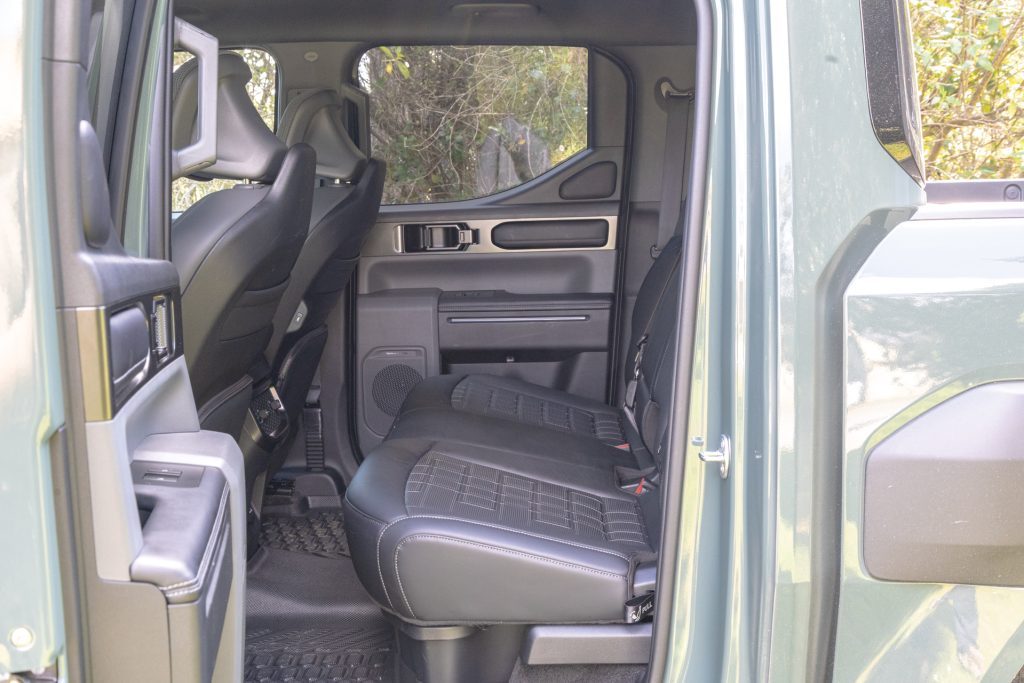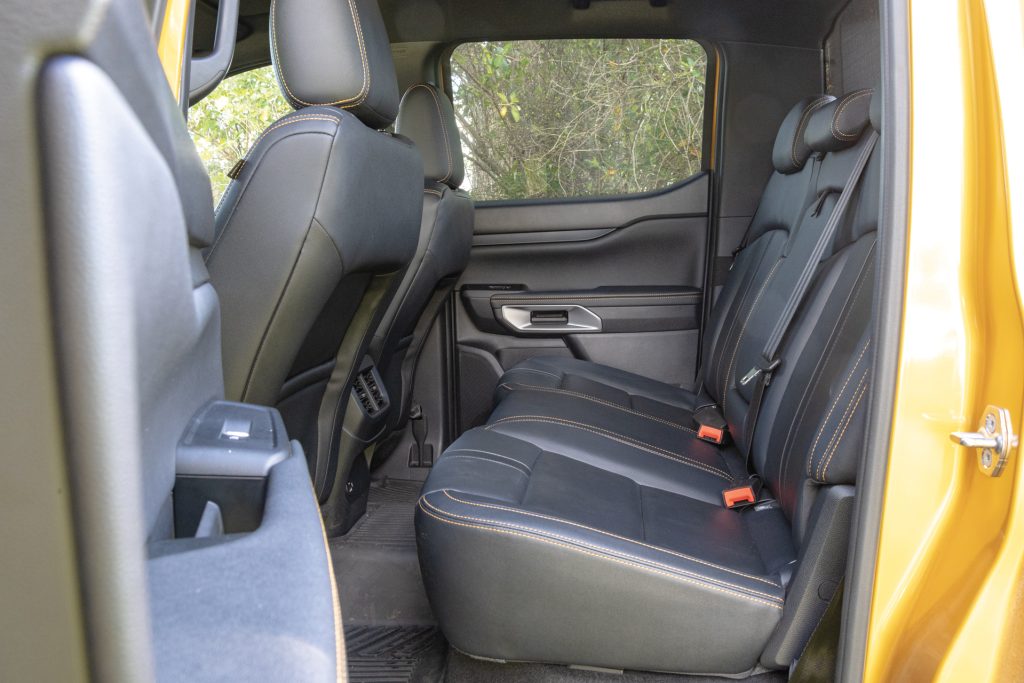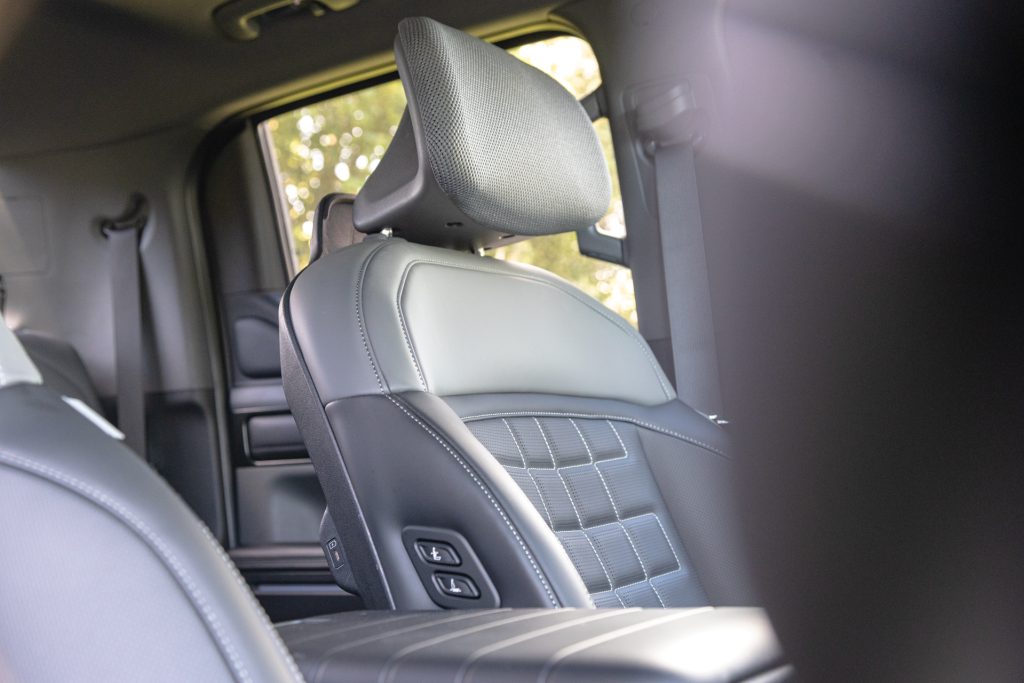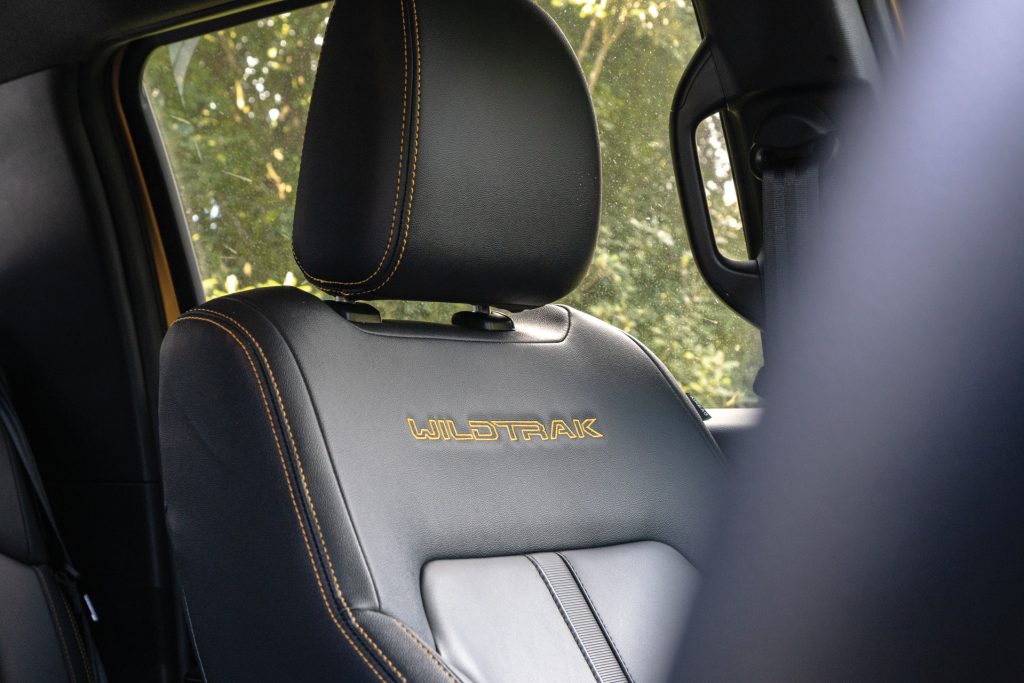2025 KIA Tasman X-Pro vs Ford Ranger Wildtrak Comparison
Words: Kyle Cassidy | Photos: Alex Schultz
The Kia Tasman has arrived, giving ute buyers yet more choice in a crowded market. How does it stack up against the best-selling Ford Ranger?
The Kia Tasman has finally arrived after what seems like the longest and one of the most hyped new vehicle arrivals in some time. Guess that’s because the double-cab ute segment is so important the world over.
They’re predominantly used as work vehicles but with multiple variants you have entry-level grunt machines, middle management wagons and at the top you’ve got the likes of this X-Pro. It’s the boss truck with all the trimmings inside, the 4×4 stuff underneath, and the look to match.
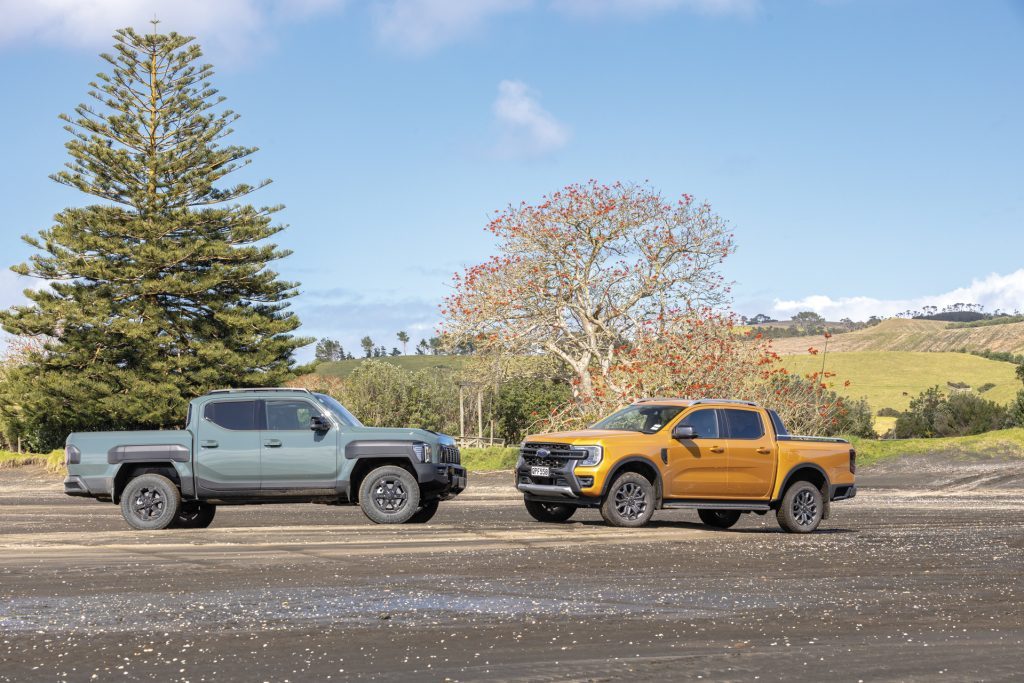
It’s targeted at the likes of the SR5 Cruiser from Toyota and the Ranger Wildtrak Ranger from Ford. But first let’s talk a little more about the Tasman.
It arrives with a five-strong line-up, prices ranging from $52,690 for the TX up to $79,690 for the X-Pro. All are double-cab wellsides with an eight-speed auto and a 2.2 diesel, and while the base model is available in 2WD, the rest feature switchable 4×4. It’s what you’d call a traditional ute too, one with a full chassis underneath and a solid axle out back located with leaf springs.
Kia is hoping Tasman will add to its sales tally, helping it rise up the ranks. It is third in passenger vehicle sales YTD, 300 or so behind Mitsubishi. But overall, it’s fourth, some 2300 sales behind Mitsubishi thanks to 2200 Triton’s sold. So having a ute sure lifts sales.
Kia NZ MD Todd McDonald says the Tasman range is targeted at volume. “Everything from our base model TX all the way through to X Pro is specific and targeted. We have double-cab chassis and single-cab chassis variants coming, which are also targeted at specific customers within New Zealand. Next year our target would be to hit the top five in New Zealand for commercials in our first full year of sales.”
Styled to sell?
One of the more talked about Tasman topics are those looks, with many disparaging comments made in the online cess pits of humanity, aka social media. Asked to describe the Tasman’s styling, McDonald says it’s ‘fresh, modern, new generational.”
As to the comments online that people either love or loathe it, he says; “Give it a year. I think this kind of styling will become quite mainstream. We’ve seen a lot of other manufacturers moving towards the US-style body shape. I think that’s where the direction of the ute is going. I think you might see traditional brands also moving towards that same style.”
The powertrain is very conventional, a new development of the group’s R Series, fettled for life in a truck. Making a competitive 154kW, the torque, at 440Nm, is a touch off the pace. It’s matched to an eight-speed auto, also configured for ute use with towing and off-roading in mind. This combo ensuresthe Tasman stacks up in terms of towing with a 3.5 tonne braked rating. And the payload stats are impressive too, the X-Pro rated at over 1000kg.
Kia is promising that servicing costs are competitive too, saying it’s second only to the Hilux.
A truck or an SUV?
Climbing up into the Kia Tasman X-Pro you’re greeted with a polished cabin. Like many new-gen utes, it feels distinctly SUV-like up front. There’s still a utilitarian edge to the design however, with a sense of durability. The materials impress with a smart blend of soft-touch surfaces and harder-wearing plastics, while the front seats feel as though they’ve been lifted straight from a Sorento, only widened slightly to suit the ute crowd. Adjustment is generous, with electric movement, lumbar support and a good range of steering wheel reach.
Clever packaging helps too. Kia mounts the gear selector on the steering column, freeing up console space for dual wireless phone chargers, USB ports, deep cupholders and a sizeable centre bin that doubles as a makeshift table. The twin digital displays are largely intuitive, supported by physical buttons for the basics. While the small ventilation screen is partly obscured by the wheel, and the infotainment can lag slightly between menus, our main gripe is with the squared-off steering wheel; it just feels odd.
Out back, the Tasman’s rear bench reclines slightly for extra comfort, the flat floor makes a three-abreast fit more feasible, and lift-up seat bases reveal hidden bins. Trim quality back there is solid as well, Isofix is included and the finer details like grab handles and extra padding in a few places have been considered.
Switching into the Ford Ranger Wildtrak ($76,990 for the bi-turbo) shows how quickly time moves on. The Kia makes the Ranger feel dated in terms of materials and overall polish. The plastics aren’t as good, and while seat comfort is decent, Kia edges ahead here. However, the Wildtrak’s cabin is still well laid out, and Ford’s portrait-style central screen relays way more usable viewing inches, especially when using the sat nav map and cameras. The physical ventilation controls are easy to use, as are Ford’s interior door handles.
Both gear selectors have quirks, the Kia’s column lever isn’t sited perfectly, while Ford’s electronic shifter makes it hard to select R when you’re in a rush.
The newer Kia has more of everything because that’s what people want. Where the Ford has heated seats in the front, the Tasman has ventilation too, a heated wheel, and also seat warmers in the rear. Wildtrak has a charge pad and some USBs whereas the Tasman has two chargers and more plugs and ports, including a 240V three-pin plug. Rear seat space is close, with similar legroom, but the Tasman again takes the lead on comfort and versatility. Its wider bench and reclining function make it more accommodating, and the 60/40 split-fold seat bases are more useful than the Ranger’s single-piece design.
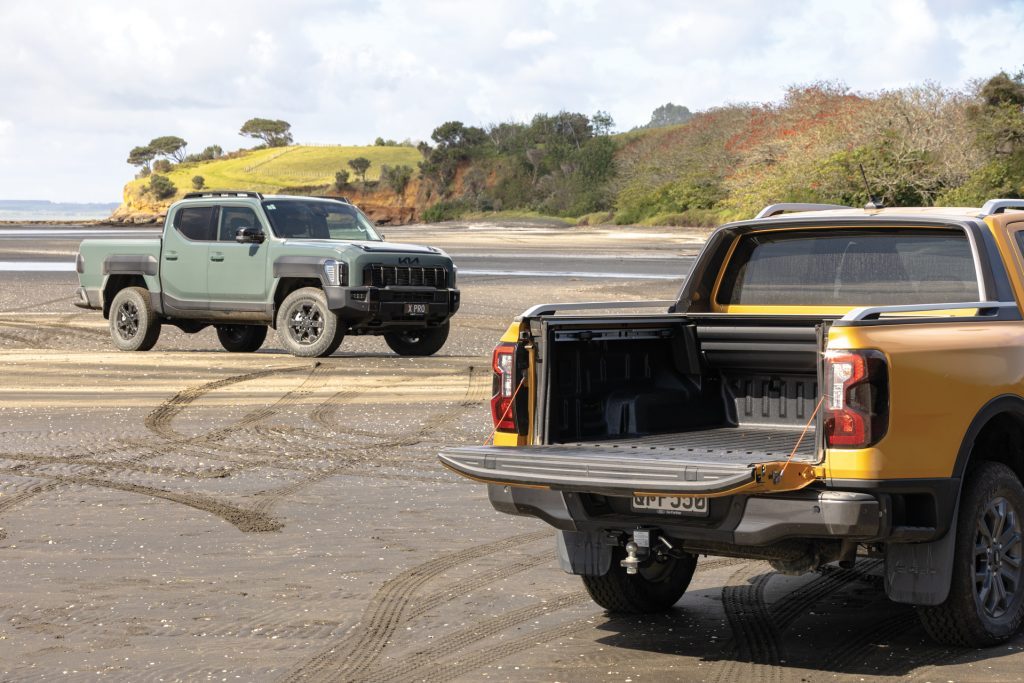
Useful utes
Drop the Wildtrak’s tailgate and it lands with a thump whereas the Tasman’s lowers with a nicely damped action. Both are easy to lift back into place. Tray dimensions favour the Kia. The Tasman measures 1300mm wide at the tailgate (1200mm between the arches) and 1500mm long, with a depth of 550mm versus the Ranger’s 500mm. The Wildtrak is 1200mm wide at the gate and arches, 1460mm long at the base of the deck, but the housing for the standard-fit roller cover robs a heap of usable length, falling to 1150mm. However, the roller cover is a good option for the Wildtrak, powered too, whereas you’re having to spend extra for a tray storage solution on the Tasman. Both provide multiple tie-down points, drop-in liners and tray lighting.
Each has onboard power, Kia fitting a 240V three-pin outlet where Ford sticks with a 12-volt. Payloads are just over 1000kg for the Tasman, and just under for the Ford, while both claim the same 3500kg braked towing limit. A towbar comes standard on the Ranger, but needs to be optioned on the Kia. Both have a trailer brake switch in the cabin.
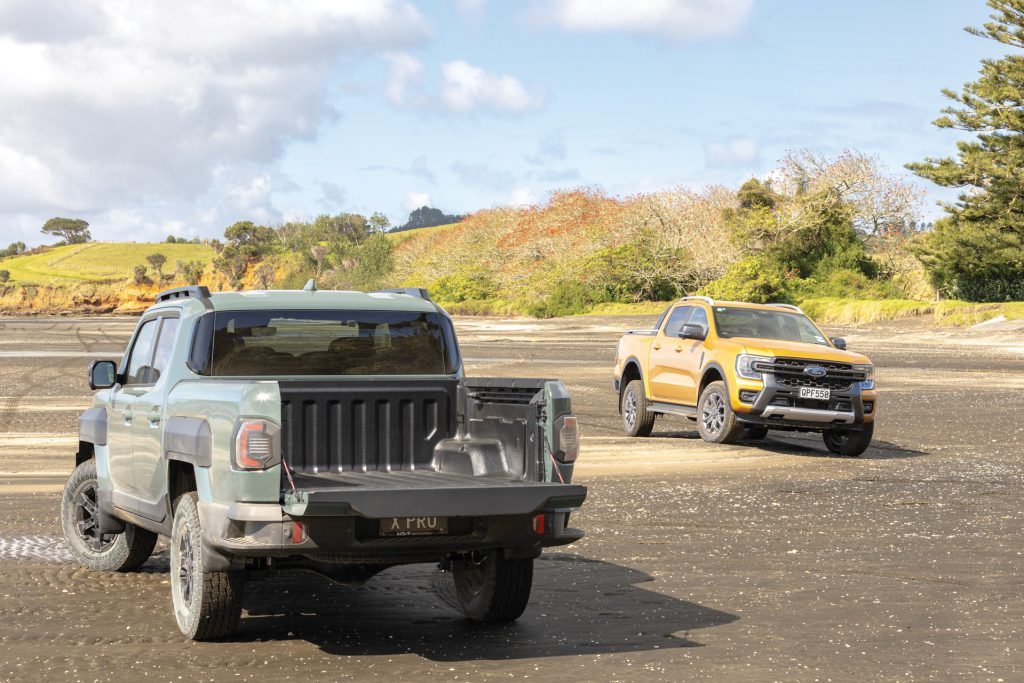
Go okay?
One aspect of the Tasman they haven’t quite nailed is the unladen ride. At both urban and open-road pace it can fidget and jiggle, while the Ranger is more settled and composed. Steering is light in both, with decent turn-in, though the Tasman is prone to the odd bump-steer through rougher corners. On smooth tarmac, however, the Kia holds a cleaner cornering line, whereas the Ford’s front treads start squirming earlier. On gravel the Tasman’s 4A mode is a good advantage, giving it sure-footed traction. The Ranger needs to be slotted into 4H to stay tidy on loose surfaces, though it remains predictable.
Kia’s 2.2-litre diesel and auto pairing is well-honed. Low-down torque arrives early, with little lag, and the gearing helps it launch quick smart. The auto responds rapidly when asked for more, rarely dithering. Its engine is also smoother and quieter than the Ford’s 154kW/500Nm 2.0-litre bi-turbo. Kia adds a Sport drive mode, making the powertrain perkier on winding roads.
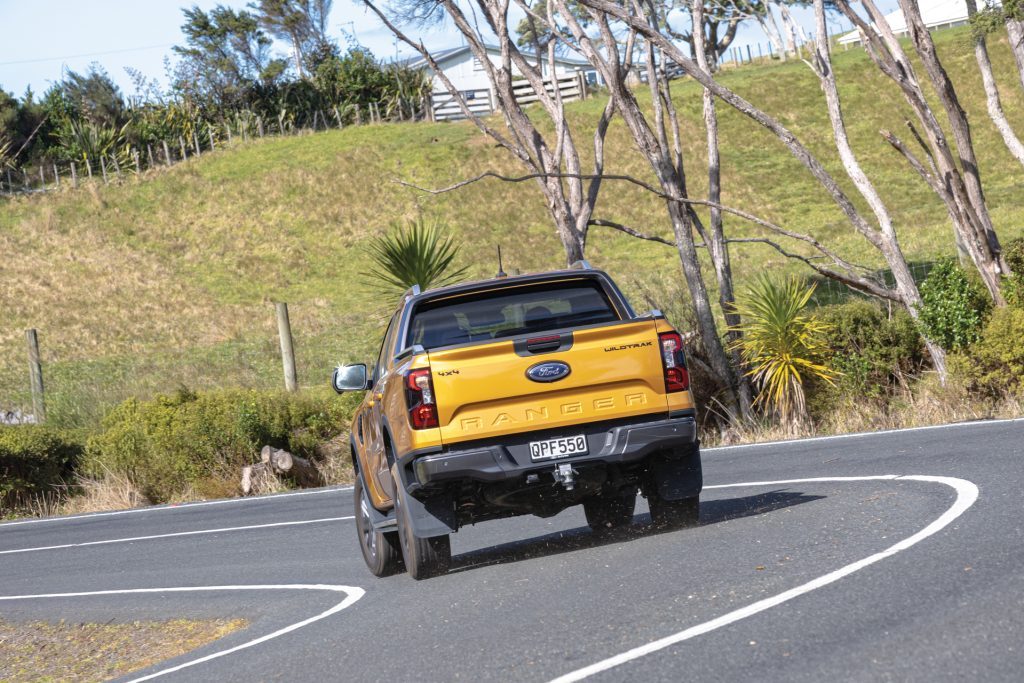
By comparison, this Ranger we had felt sluggish, with its ten-speed auto quick to pluck taller gears while being reluctant to downshift under load. It gave the impression of being locked in Eco mode. It’s not something we’ve experienced with this drivetrain previously, where the auto has been, if anything, overly keen to swap gears. Perhaps Ford has updated its protocols somewhere along the line. For overall fuel consumption they are fairly close: both hover around 10L/100km, with the Ranger typically a fraction thriftier.
Being newer, the Kia brings extra safety tech. The driver-monitoring system isn’t overbearing, and its lane-keeping assistance works neatly on motorways (though, like Ford’s, it’s best switched off on back roads). The Ranger constantly prompts you to keep your hands on the wheel even on straights, which can become tiresome.
Both pack the expected suite of modern assists – adaptive cruise, blind-spot monitoring, and collision avoidance – but Kia’s newer electronics add features like a BSM camera system.
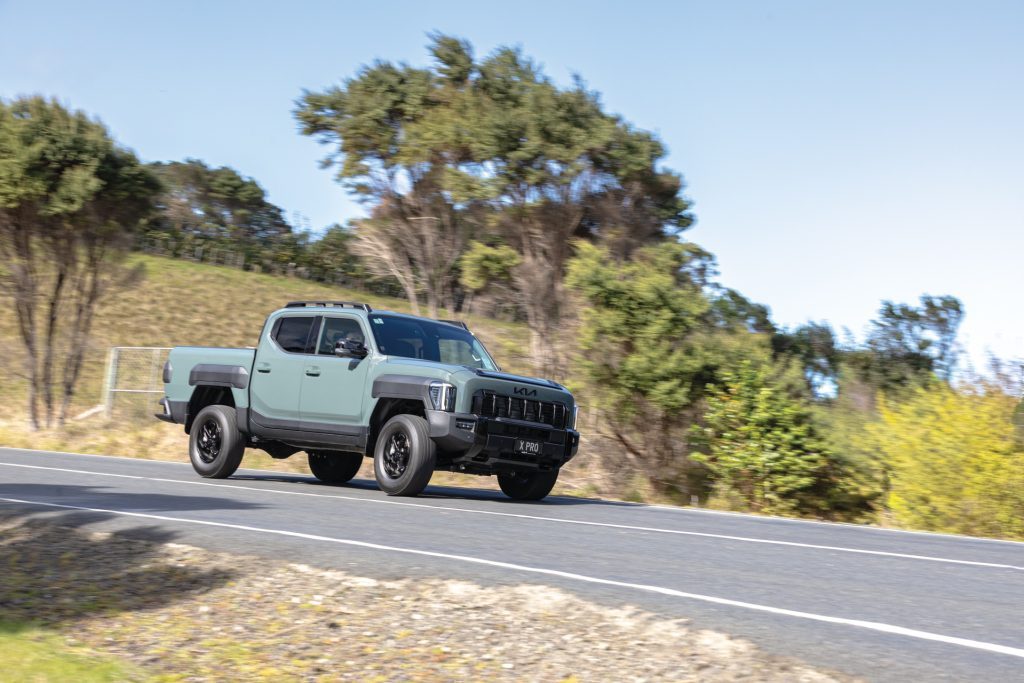
In the rough
We tried the Tasman off-road at the recent product launch where the X-Pro impressed with its ample ground clearance and rear axle articulation. Kia’s X-Trek system is like an off-road cruise control for hill descents and rock crawling. It works well, though when adjusting the speed, it’s all too easy to press the button down, which then switches it off.
The Ranger Wildtrak sticks with a more traditional 2H/4H/4L set-up for its 4×4 hardware, whereas Kia adds in the 4A setting. Ranger offers various drive modes for towing and slippery conditions, much like the Tasman. Hill descent control is effective and smooth, but Kia’s tech feels a generation newer. Both trucks are highly capable off-road, but the Tasman edges ahead for clearance, traction options and its camera system, which offers a clearer view than the Ford’s.
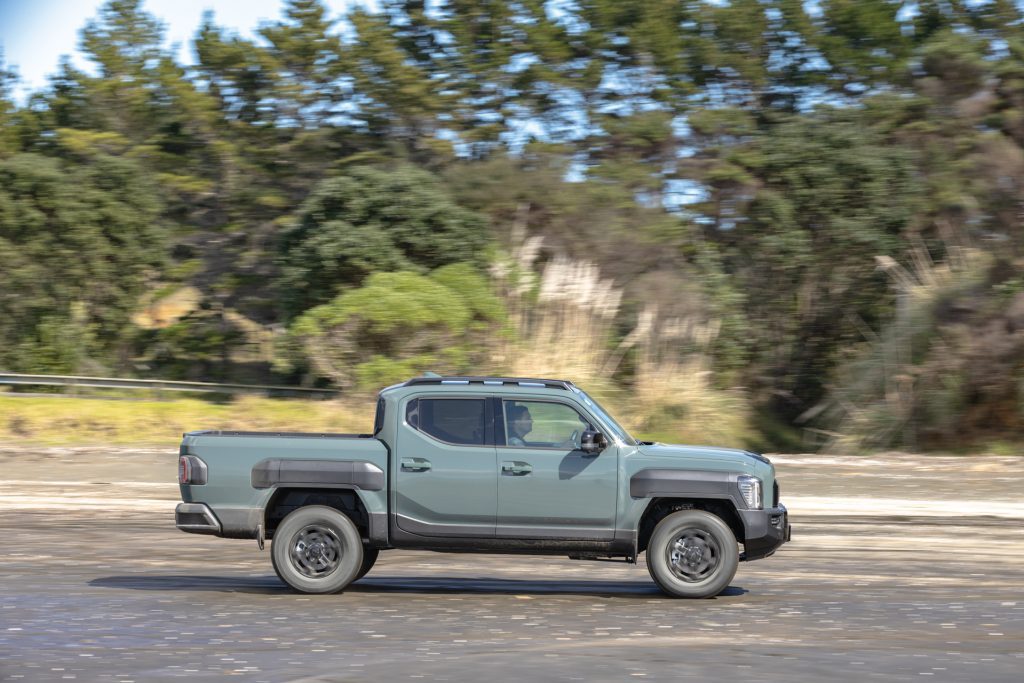
A clear winner?
Kia has done a great job with Tasman. The X-Pro hits all the criteria for a top-spec truck, it really is quite good. Not perfect, but well polished. The divisive styling will decide it for most however. Pricing is competitive, and while it offers more convenience and comfort items, you’ll need to pay extra for accessories whereas the Wildtrak is kitted out with a tow bar and tray cover for a slightly lower ask. And you can buy a more powerful V6 version of the Wildtrak too. But the Tasman is more than a match for Ranger, so it will be interesting to see how the sales numbers compare this time next year.
Kia Tasman X-Pro 4×4
$79,690 / 9.3L/100km / 245g/km
0-100 km/h 9.58s
80-120 km/h 7.54s (213m)
100-0 km/h 39.10m
Speedo error 97 at an indicated 100km/h
Ambient cabin noise 70.0dB@100km/h
Engine 2151cc / IL4 / TDI
Max power 154kW@3800rpm
Max torque 440Nm@1750-2750rpm
Drivetrain 8-speed auto / switchable 4×4
Front suspension Wishbones / swaybar
Rear suspension Solid axle / leaf springs
Turning circle 12.5m (3.2 turns)
Front brakes Ventilated discs (325mm)
Rear brakes Ventilated discs (325mm)
Stability systems ABS, ESP
Safety AEB, ACC, BSM, LDW, RCTA, ALK, AHB
Tyre size f/r-265/70R17
Wheelbase 3270mm
L/W/H 5410 / 1930 / 1920mm
Track f-1636mm r-1624mm
Fuel capacity 80L
Tow rating 750kg (3500kg braked)
Service intervals 12 months / 15,000km
Warranty 5yrs / 150,000km
ANCAP rating Not rated
Weight (claimed) 2238kg
Ford Ranger Wildtrak
$75,990 / 8.3L/100km / 218g/km
0-100 km/h 9.32s
80-120 km/h 7.10s (204m)
100-0 km/h 38.95m
Speedo error 97 at an indicated 100km/h
Ambient cabin noise 71.1dB@100km/h
Engine 1998cc / IL4 / TDI
Max power 154kW@3750rpm
Max torque 500Nm@1750-2000rpm
Drivetrain 10-speed auto / switchable 4×4
Front suspension Wishbones / swaybar
Rear suspension Solid axle / leaf springs
Turning circle 12.4m (3.2 turns)
Front brakes Ventilated discs
Rear brakes Discs
Stability systems ABS, ESP
Safety AEB, ACC, BSM, LDW, RCTA, ALK, AHB
Tyre size f/r-255/65R19
Wheelbase 3270mm
L/W/H 5370 / 1918 / 1883mm
Track f-1610mm r-1610mm
Fuel capacity 80L
Tow rating 750kg (3500kg braked)
Service intervals Variable
Warranty 5yrs / 150,000km
ANCAP rating ★★★★★ (2022)
Weight (claimed) 2270kg
